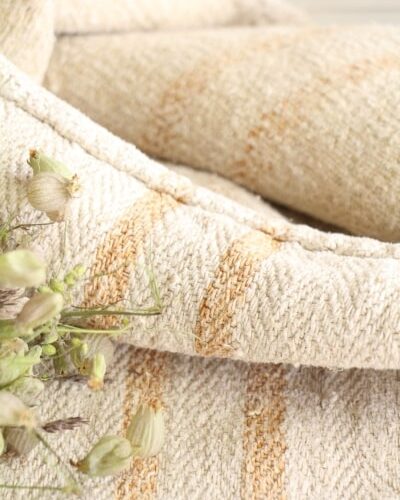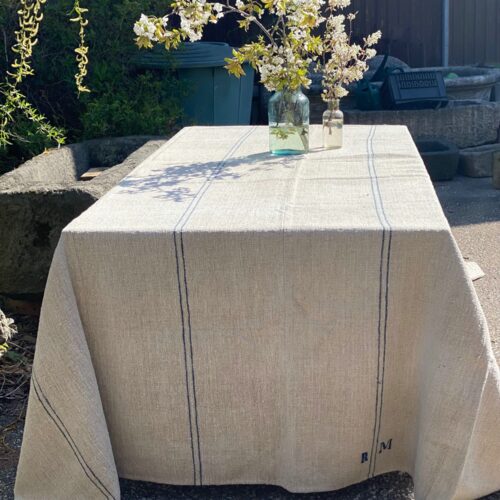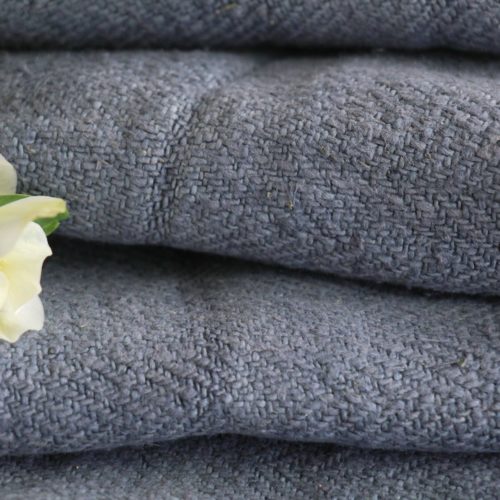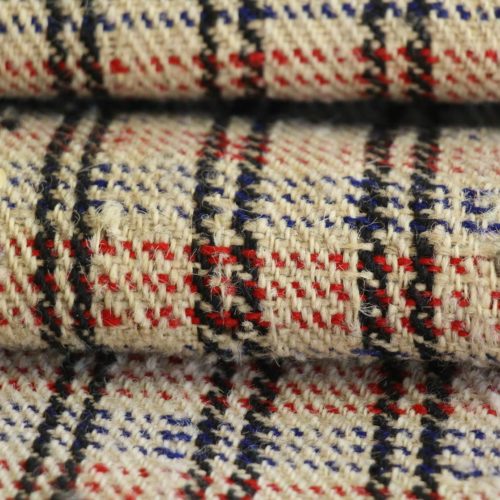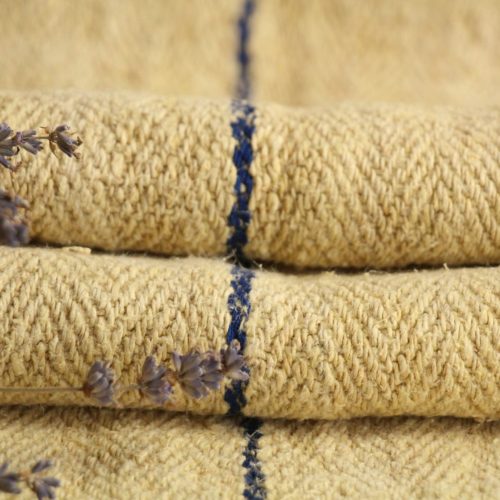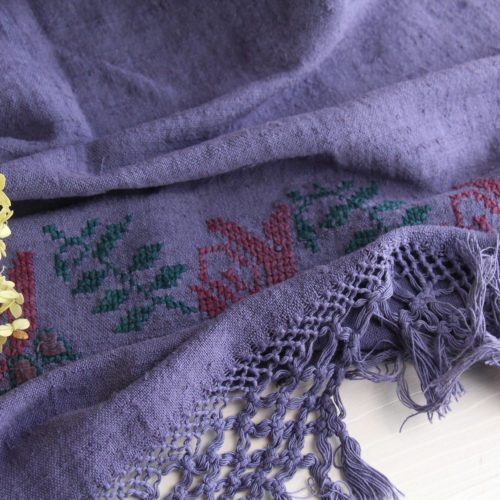Linen
-
antique dyed cotton linen roll T 487
€ 252,00 -
antique dyed french linen roll T 491
€ 256,00 -
antique dyed french linen roll T 489
€ 149,00 -
antique french linen roll TW 477 gogmul jalu
€ 175,00 -
antique hand-loomed wool-linen roll T 480
€ 340,00 -
antique french linen roll TW 472 gogmul jalu
€ 93,00 -
antique dyed grain sack linen roll T 467 gogmul jalu
€ 145,00 -
HP 977 antique french linen grain sack grainsack offwhite pink stripes
€ 52,00 -
antique linen roll TOMATO RED stripes 3.06y TW 461 gogmuljalu
€ 90,00 -
HP 966 charming antique french linen grain sack grainsack pale oatmeal seagreen stripes
€ 50,00 -
HP 967 charming antique french linen grain sack grainsack pale oatmeal seagreen stripes
€ 50,00 -
HP 968 charming antique french grain sack grainsack pale oatmeal seagreen stripes
€ 50,00 -
Antique dyed tablecloth D 730 gogmul jalu
€ 145,00 -
antique charming dyed linen TOWEL D 735 handstitched embroidery gogmuljalu
€ 30,00 -
antique charming dyed linen TOWEL D 736 handstitched embroidery gogmuljalu
€ 30,00
You have seen 1312 of 1390 Products
How linen fabrics inspired our love for handmade natural products
Natural freshness and the lightness of nature moves in to your home with precious linen fabrics. The sustainable fabrics made of flax impress through their charm and gloss and offer a variety of benefits, that make them unique. The wonderful look of linen, coming from the natural colour nuances and the varying textures gifts the products unbelievable versatility. Thus, linen fabrics can be used in different areas - especially in the field of interior design combined with modern or antique furniture. No other fabric transmits so much warmth and comfort, when used as a home textile in the form of pillow cases, tablecloths or tablerunner, towels, duvets, curtains, or napkins to transform the entire atmosphere of a room. Furthermore linen fabrics are easy-care and become more beautiful and softer with each washing cycle. Some of our antique linen fabrics from 1870-1900 even are as smooth as silk. Additionally no other fabric is cultivated, harvested and processed in a more sustainable way than linen. In the following text you will learn everything about linen fabrics and what makes them so special.
The material linen are made of
Where does linen come from? Linen are made from the fibres of flax. It takes one hundred days until the soft and skyblue blossoms reach their full ripeness and are ready to be harvested. Thereby all flax plants are entirely plucked from the ground along with their roots and stay on the field to dry properly. Mowing would destroy the fibres of the plant. During the drying process the particularly thick epidermis of the flax bursts open and lets bacteria and fungi enter the inside of the plant. The removal of the fibre bundles from the surrounding tissue through microorganisms is called retting. To receive a high-quality linen fabric, the dried flax needs to be processed. In a multilevel process the flax plants are ribbed, ginned, broken, oscillated and steamed until all impurities are removed. Twisted into braids, the long fibres are brought to a spinning mill where they are spinned to yarns. Afterwards, the linen is weaved to become tissue, which is refurbished by a string of processes. The time-consuming processing of flax fibres is always paying off, keeping its longevity and its benefits compared to other fabrics in mind.
Linen fabrics are wonderful - the fabulous characteristics of linen fabrics
Linen are used by humans for more than 30.000 years and celebrated their revival in the 20th century in the fashion industry and for interior design. Justifiably so. No other fabric comes up with as many positive characteristics. Natural linen fabric is an eye catcher and incredibly durable. The older linen products get, the softer and more beautiful they become. Our antique linen fabrics therefore convince with their silk-like smoothness and impressive colour-compositions. Linen are durable because of their unmatched robustness, though this doesn’t impact the comfort of linen in any way. It’s the other way round: linen are breathable, velvety, lint-free and temperature regulating, so they keep you warm in winter and cool you down in summer. Furthermore, linen fabrics are dirt-repellent and easy-care. If it gets wet, the liquid will be absorbed in an instant and the tissue is fully dried soon too. As linen are naturally germicidal, antistatic and antibacterial, they are ideal for people with allergies or neurodermatitis. Lastly, the cultivation of linen is resource-friendly and the fibres are biologically degradable.
The benefits of linen in a nutshell
- Durable and tear-resistant
- Naturally germicidal and antibacterial
- Easy-care
- The most sustainable fabric of them all
- Biologically degradable
- Very robust
- lint-free
- Soft and comfortable on the skin - especially antique linen
- Breathable
- Temperature regulating
- Ideal for people with allergies
- Dirt-repellent
- Dries easily and perfectly absorbs liquids
- Cools in the summer, keeps warm in the winter
- Linen fabrics become softer and more beautiful, the older they get
Linen - The most sustainable and resource-friendly fabric of them all
If we take a closer look at the cultivation, linen are a step ahead compared to other fabrics, because the cultivation of flax is more sustainable as long as it is done in a sensible and traditional way. Chemical fertilisers and pesticides are not being used at all. Furthermore, the cultivation of linen only needs small amounts of water and it is resource-friendly too. Additionally the traditional cultivation of flax preserves the ground, as dried linen return many nutrients to the soil during the retting. Since our linen products are antique and originate from the late 18th and early 19th century, sustainable cultivation and processing is guaranteed. Lastly, linen are biologically degradable and do not harm the environment in any way. Even though there are two types of retting (water retting and dew retting), which cause burdensome wastewater, these methods are neither suggested nor supported.
Why linen is the better cotton
Although humans are delighted for ten thousands of years by the wonderful qualities of linen, cotton replaced flax in most sectors with the rise of industrialisation. The reason for that was simple: cotton was cheaper as well as easier to cultivate and process. Nevertheless, linen fabrics rose like a phoenix from the ashes in the 20th century because of his countless benefits and is getting more popular by the minute. Quality, durability and sustainability become more important for customers and linen fabrics perform far better than cotton in all of these areas. The cultivation of flax needs far less water as well as energy and is more sustainable in every other way too. Rain is sufficient to water linen-fields. Furthermore, flax does not have high standards regarding soil. Cotton on the other hand needs huge acreage, great soil and tons of pesticides. As the processing chain of linen fabrics is purely mechanical, no chemicals are needed either. In contrast formaldehyde containing artificial resins, ammonia, sodium bicarbonate, chemical plasticisers, heavy metals and more polluting substances is used for the processing of cotton. If we compare the characteristics of the final product, linen fabrics are more durable, more robust as well as antibacterial and dirt-repellent.
The difference between full linen and semi linen
As the name suggests, full linen merely consist of linen. Pure linen can be recognized by the twine-bulges at the cross and vertical threads and are perfect for hot summers, as the fabrics keep you cool but also protect your skin from sunlight. Half linen on the other hand are hybrids consisting of about sixty percent cotton yarn and forty percent linen yarn. The cotton yarn is interwoven in warp direction (lengthwise) and the linen yarn in weft direction (cross). Because of the high share of cotton, half linen become very soft and keep you warmer.
The right care of linen fabrics - Quality that lasts forever
No other fabric can claim, that it gets prettier, shinier and softer with each washing cycle. This is one of the wonderful benefits of linen fabrics. While other fabrics are damaged by the lye of detergents, linen is insensitive to alkaline solutions. This is great news for linen products of daily use. Bed sheets, bed linen, towels or dish towels made from linen are washable in hot water up to 95°C and easy-care. There are also linen fabrics, that need to be washed in a gentle cycle at 40°C. Thus it is important to always ask the trader, if there are certain care instructions for the product you have bought. Even though linen fabrics can be ironed, they wrinkle easily. But this can be avoided by just filling the washing drum halfway and by reducing the spin cycle to a maximum of 600 rotations per minute. The use of bleach just damages the natural fibres unnecessarily. Linen fabrics are dirt-repellent and antibacterial anyway. Linen fabrics feel most comfortable in the fresh air, but without being directly in the sun, as this can bleach the fabric.
Antique linen have a special charm
In our online shop you will only find antique linen from the 19th and early 20th century. We have succumbed to the charm of antique linen and are enchanted by its beauty. These wonderful fabrics are older than 100 years, still they managed to maintain their grace, or even multiplied it. Stored in old sideboards or dusty chests, antique linen fabrics have not lost anything of their elegance or noblesse. Instead they matures like fine wine. After a long rest, they were rediscovered from us in second hand stores, garage sales or private sales all over the world and refurbished with devotion and love. Now they wait to spread their charm in your home.
Buy antique linen and linen fabrics at Grainsack
You can find a big selection of adorable linen products as well as linen fabrics in our online shop, which just wait to beautify your home. These include antique linen in the best possible condition and in various patterns and colours. Some of our linen products are sewed as ready-made products, like linen-pillowcases, linen tablecloths, linen dish towels, linen towels, linen napkins or linen grainsacks. But we also sell rolls of linen or linen yard goods which can be customized by our individual sewing service to make linen bags and further products from antique linen fabrics.

